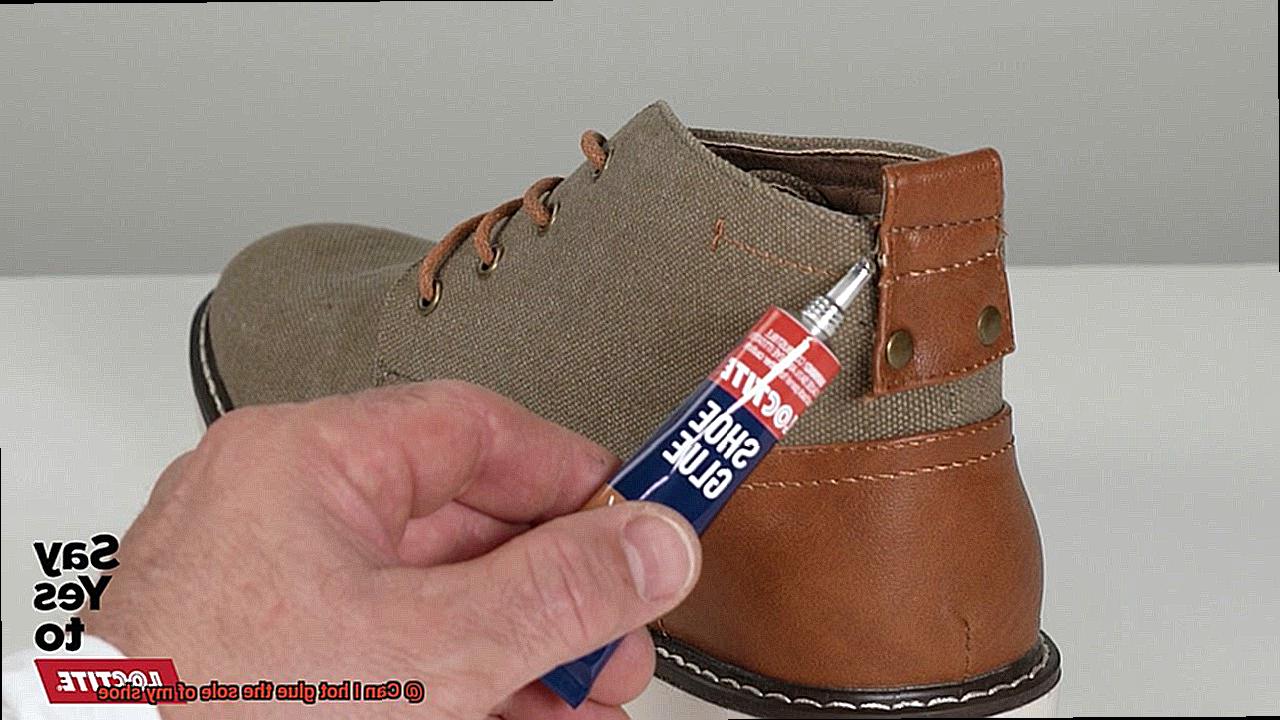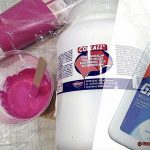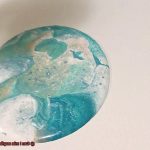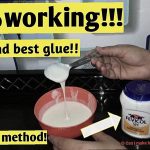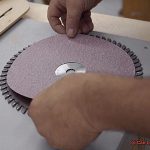Picture this: you’re strutting down the street, feeling confident in your favorite pair of shoes, when suddenly disaster strikes. The sole starts to peel away, threatening to leave you hobbling like a wounded gazelle. But fear not, my friend, because today we’re going to tackle a burning question: Can I hot glue the sole of my shoe?
Imagine a world where shoe repairs weren’t a hassle or an expensive affair. A world where you could fix your worn-out soles with a simple tool that’s probably sitting in your junk drawer right now. Well, my fellow shoe enthusiasts, that world exists, and it’s called the magical combination of shoes and hot glue.
But before you grab your trusty glue gun and dive headfirst into this DIY adventure, let’s take a moment to understand the ins and outs of hot gluing soles. In this article, we’ll explore the advantages and drawbacks of this crafty solution while sharing expert tips to ensure your repair is nothing short of fabulous.
First things first: let’s discover why hot glue might just be the answer to your sole-separation woes. We’ll delve into how this humble adhesive can save you time and money while giving your beloved kicks a new lease on life. And don’t worry – we’ll guide you through the maze of hot glue options out there so you can choose the perfect one for your specific needs.
Now, let’s address the elephant in the room – are there any downsides to using hot glue for shoe repairs? We’ll reveal all the nitty-gritty details about durability and longevity so you can make an informed decision. Should you view it as a temporary fix or something more long-term? Get ready for some eye-opening insights.
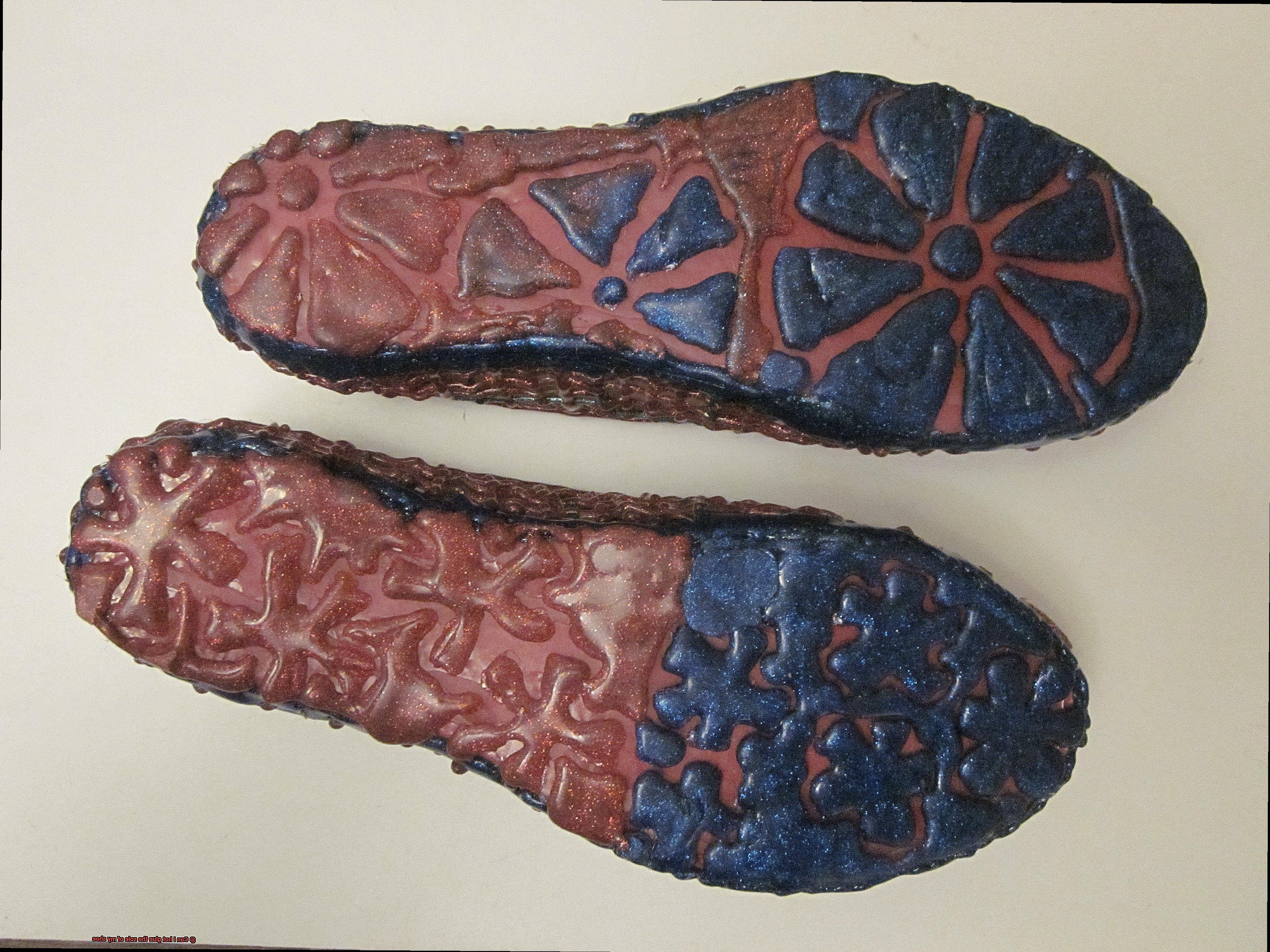
But wait. Before we wrap up this journey into shoemaking hacks, we have some invaluable tips and tricks up our sleeves. From prepping your shoe for the glue to ensuring a comfortable fit, these insider secrets will take your DIY repair skills to new heights.
So, whether you’re a frugal fashionista or just someone who wants to get their shoes back on track ASAP, join us on this exciting adventure as we explore the world of hot gluing shoe soles.
Get ready for a rollercoaster ride of creativity and practicality that’ll leave you walking tall once again.
What is Hot Glue?
Contents
- 1 What is Hot Glue?
- 2 Why Is Hot Glue Not Recommended for Shoe Soles?
- 3 What Are the Alternatives to Hot Glue?
- 4 Adhesive Products Specifically Designed for Shoe Repairs
- 5 Different Types of Materials Used for Shoe Soles
- 6 Factors to Consider When Choosing an Adhesive Product
- 7 How to Use Adhesive Products for Shoe Repairs
- 8 Professional Assistance for Shoe Repairs
- 9 Conclusion
Hot glue is a popular choice for DIY projects and repairs due to its versatility and ease of use. However, when it comes to repairing the sole of a shoe, hot glue may not be the most suitable option. In this article, we will explore what hot glue is, its uses, and why it may not be the best choice for shoe repairs. We will also discuss alternative adhesive products specifically designed for shoe repairs.
What is Hot Glue?
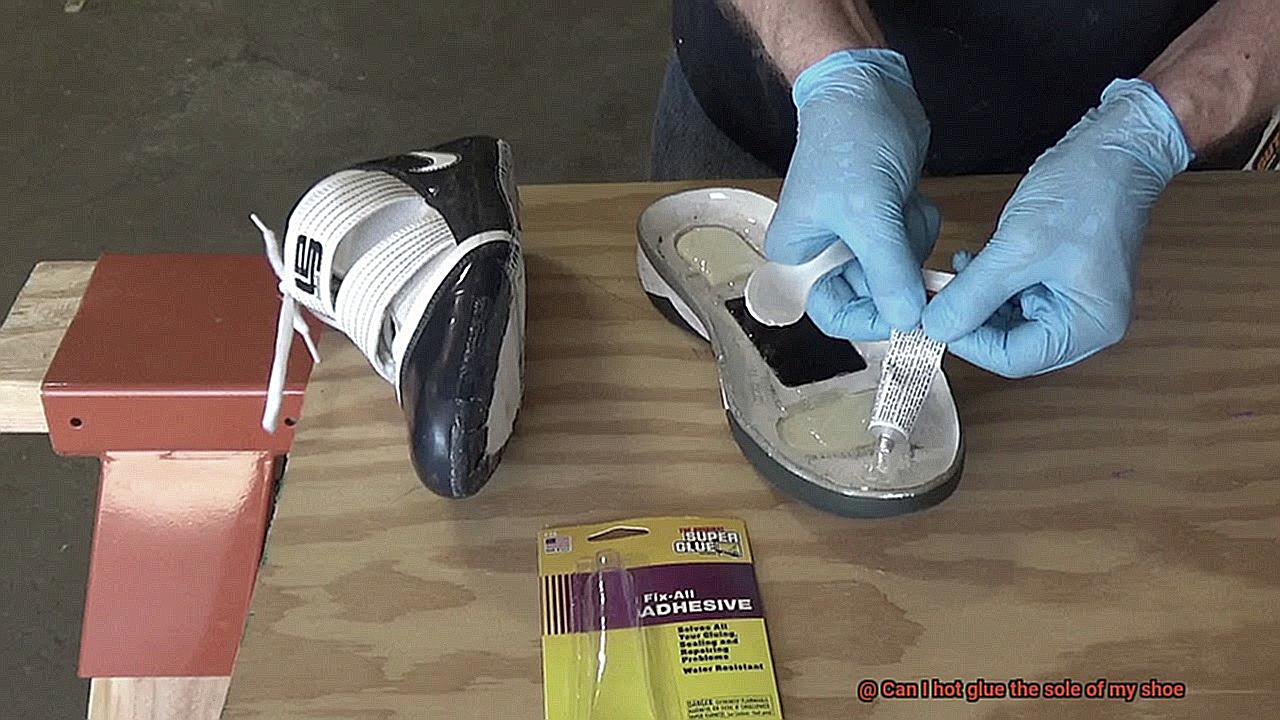
Hot glue, also known as hot melt adhesive, is a thermoplastic adhesive that comes in cylindrical sticks or pellets. It is applied using a glue gun, which melts the adhesive and allows it to flow onto surfaces. As the hot glue cools down, it solidifies and forms a strong bond.
Versatility of Hot Glue:
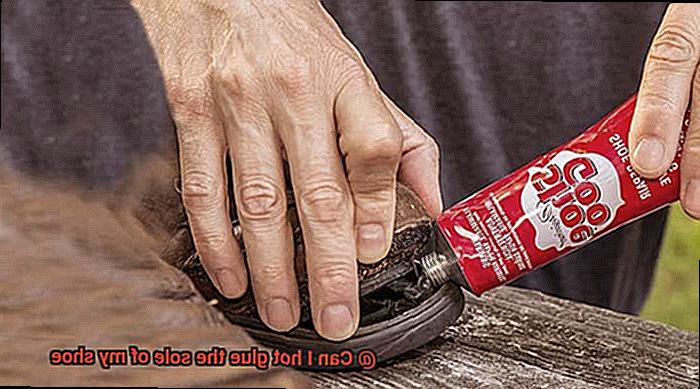
Hot glue is valued for its ability to bond a wide range of materials, including wood, plastic, fabric, metal, ceramic, and certain types of glass. Whether you’re working on crafts or fixing broken items around the house, hot glue can often provide a reliable and durable bond.
Advantages of Hot Glue:
Hot glue offers several advantages over other adhesives. Its low viscosity when melted allows it to penetrate porous surfaces for strong bonds. Additionally, hot glue has a fast setting time, drying quickly once applied. This is useful for time-sensitive projects or immediate repairs. Moreover, hot glue can be softened and removed by applying heat, allowing for repositioning or removal if needed.
Limitations for Shoe Repairs:
- Insufficient Durability: The constant wear and tear experienced by shoe soles can be too much for hot glue to handle. Exposure to heat or prolonged pressure can cause the glue to soften and become less adhesive, leading to detachment.
- Lack of Flexibility: Hot glue is not flexible and may crack or break when the shoe bends or flexes during walking or running. This can compromise the integrity of the repair and result in further damage.
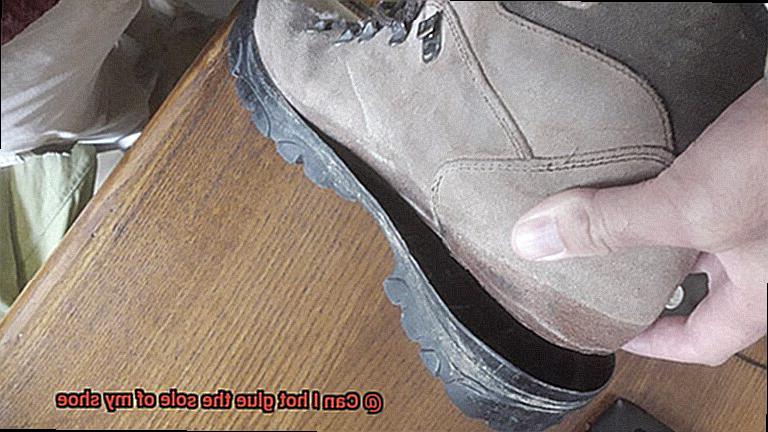
Alternative Adhesives for Shoe Repairs:
For shoe repairs, there are alternative adhesive products specifically designed to withstand the demands of footwear. These adhesives provide superior durability and flexibility to ensure long-lasting repairs.
Examples include shoe repair adhesives, such as shoe goo or specialty shoe adhesives recommended by shoemakers and cobblers.
Why Is Hot Glue Not Recommended for Shoe Soles?
Today, we’re delving into the fascinating world of shoe sole repair and why hot glue is the arch-nemesis of your beloved footwear. While hot glue may be a handy tool for countless DIY projects, it’s time to uncover the truth about its unsuitability for shoe soles. Brace yourselves – this is going to be a wild ride.
First and foremost, let’s talk durability. Shoe soles experience an endless barrage of stress and wear, enduring the weight of every step, the pressure of each stride. Unfortunately, hot glue simply can’t handle this level of intensity. It succumbs to heat and pressure faster than a melting popsicle on a sweltering summer day. Picture your soles waving goodbye mid-walk – not exactly what you signed up for, right?
Now, let’s address flexibility – a pivotal trait for shoe soles. They need to bend, twist, and flex with each step, ensuring maximum comfort and minimizing the risk of injury. But hot glue? It’s as rigid as an obstinate toddler refusing to eat their greens. Imagine strutting around in shoes with inflexible, glued-on soles – a guaranteed recipe for discomfort and potential foot pain.
But wait, there’s more. Cushioning and shock absorption are paramount for shoe soles, providing that delightful bounce in your step. Materials like rubber or foam excel in these areas, while hot glue falls short. Walking on hot-glued soles feels more like strolling on concrete rather than floating on clouds – definitely not the experience you deserve.
Let’s not forget about water resistance – an essential consideration for shoe soles exposed to rain, snow, or even sweat. Hot glue isn’t exactly fond of water either. Its adhesive properties weaken and dissolve faster than the Wicked Witch of the West in a torrential downpour. Say farewell to your glued soles and welcome potential shoe damage.
And here’s the kicker – using hot glue on your shoe soles might just void any warranties or guarantees provided by the manufacturer. Shoe companies often recommend specific adhesives and repair methods for a reason. Straying from their guidelines could leave you high and dry, with no recourse for warranty claims. Always consult the manufacturer’s instructions or seek professional assistance for shoe sole repairs.
What Are the Alternatives to Hot Glue?
I am here to introduce you to a world of alternative adhesives that will have your shoe soles bonded like never before. So sit back, relax, and let’s explore the exciting options that await us.
First up on our list is the incredible shoe glue. This superhero adhesive is specially designed to repair and bond shoe soles. Crafted from strong and flexible materials, shoe glue can handle all the stress and movement that our beloved shoes endure.
It forms a durable bond that can withstand anything Mother Nature throws its way, ensuring your shoes stay intact through rain, shine, and everyday wear and tear.
Enter epoxy resin, the versatile wonder adhesive. Known for its exceptional bonding properties, epoxy resin is a true game-changer in the world of shoe repairs.
It creates a bond that is strong, durable, and flexible, capable of withstanding heavy use and exposure to moisture. Just remember to follow the manufacturer’s instructions carefully to achieve optimal mixing and application.
Now let’s talk about contact cement – a force to be reckoned with in the adhesive realm. This powerful adhesive bonds quickly and securely. All you need to do is apply a thin layer to both surfaces, wait for it to dry until it becomes tacky, and then firmly press those surfaces together. The result? A long-lasting bond that can withstand all the bending and flexing your shoes go through.

But what if you’re in need of a temporary fix or a quick repair? Fear not. Double-sided adhesive tapes are here to save the day. These marvels of convenience are mess-free, easy to use, and require no drying time. While they may not provide the same level of strength and durability as other options, they are perfect for those moments when time is of the essence.
Last but certainly not least, we have the mighty super glue or cyanoacrylate adhesive. While not specifically designed for shoe repairs, some brave souls have found success using it to bond shoe soles.
Super glue works fast and forms a firm bond, but keep in mind that it may not be as flexible or durable as other adhesives made specifically for shoe repairs.
Adhesive Products Specifically Designed for Shoe Repairs
Step into the enchanting realm of shoe repairs, where adhesive products take center stage as the saviors of your worn-out soles. These remarkable adhesives are meticulously crafted to breathe new life into your beloved footwear. Today, we embark on a captivating journey through the different types of adhesive products specifically designed to work wonders on your shoes.
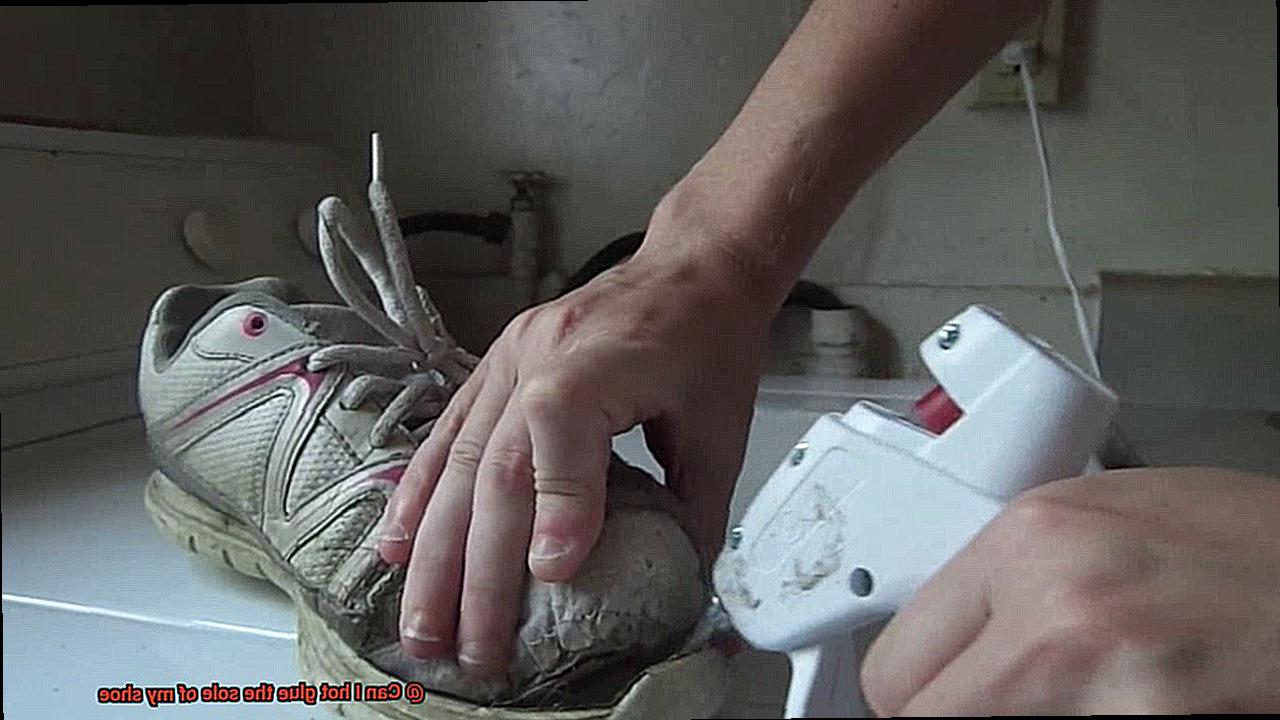
Let’s start with shoe glue, the indomitable adhesive that fearlessly tackles any challenge thrown its way. This mighty glue is expertly formulated to bond a variety of materials commonly found in shoes, such as leather, rubber, and fabric. It is the perfect choice for repairing soles that have started to separate from the upper part of the shoe. With shoe glue as your ally, you can rest assured that your repaired shoe will triumph over the trials and tribulations of everyday use.
Next on our roster is contact cement – an adhesive force to be reckoned with in the realm of shoe repairs. This formidable adhesive creates an instantaneous bond when two surfaces are brought together. If your sole has completely detached from the upper part of your shoe, contact cement swoops in to save the day. Its rapid-drying formula ensures an unyielding repair in no time at all.
But what about those shoes that have suffered significant damage or possess weak areas? Fear not, for epoxy resin emerges as the undisputed hero of the tale. This extraordinary two-part adhesive forges an unbreakable bond when its components are blended together. It serves as a guardian angel for weak areas, fortifying them with unparalleled strength and resilience. Moreover, epoxy resin effortlessly mends soles that have endured substantial damage. It bestows upon your shoes a superhero cape that protects and preserves their integrity.
However, before you embark on this exhilarating adventure of shoe repairs, it is imperative to heed the instructions provided by the manufacturer of these adhesive products. Properly preparing the surfaces, applying the adhesive with precision, and allowing ample drying or curing time are pivotal steps that ensure triumphant repairs. Remember, every superhero needs a well-crafted plan to achieve victory.
It is important to note that not all shoes can be effectively repaired using adhesive products alone. Some shoes with molded soles or those crafted from specific synthetic materials may require specialized repair techniques or the aid of professionals. Rest assured, though, for there is always a solution to every shoe predicament.
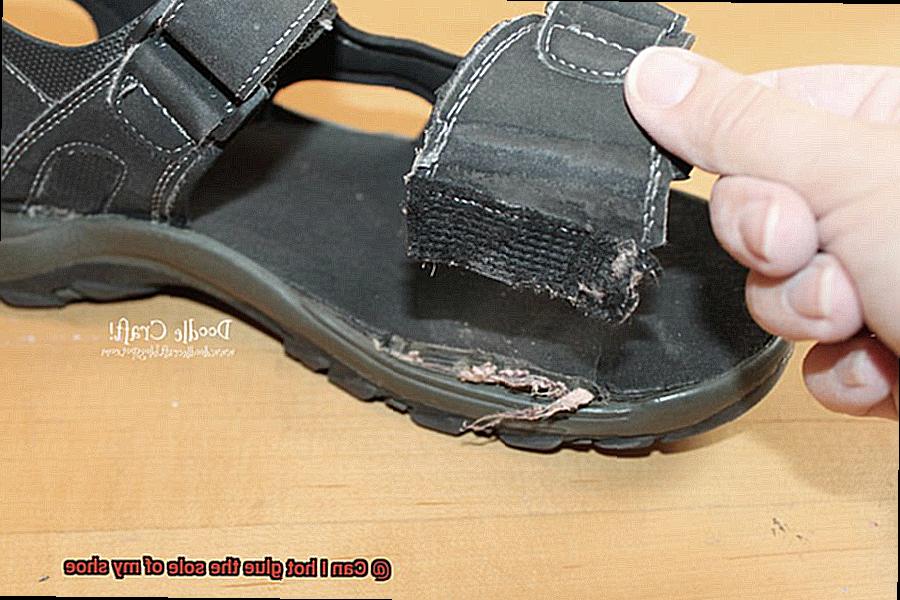
Different Types of Materials Used for Shoe Soles
Today, we embark on an exciting journey to unravel the enigma of shoe soles and explore the diverse range of materials that make them extraordinary. Join us as we delve into the captivating world of footwear engineering and discover the unique properties of these miraculous sole materials.
Rubber Soles: The Mighty Titans of Grip and Durability.
Behold the mighty rubber soles, reigning supreme in the realm of shoe-making. Renowned for their exceptional grip, they ensure your footing remains steadfast on any terrain. Whether sprinting like a cheetah or strolling through bustling streets, rubber soles offer unparalleled traction and endurance. Embracing flexibility and comfort, they bestow upon you a harmonious gait, transforming each stride into a blissful experience.
Leather Soles: The Timeless Elegance that Breathes Life into Your Feet.
Indulge in the timeless elegance of leather soles, crafted to captivate hearts for centuries. With a symphony of natural breathability, these regal soles allow your feet to bask in the cool embrace of air circulation, thwarting any unsavory foot odors. Yet, like delicate works of art, they demand gentle care and protection from water’s treacherous touch and undue wear.
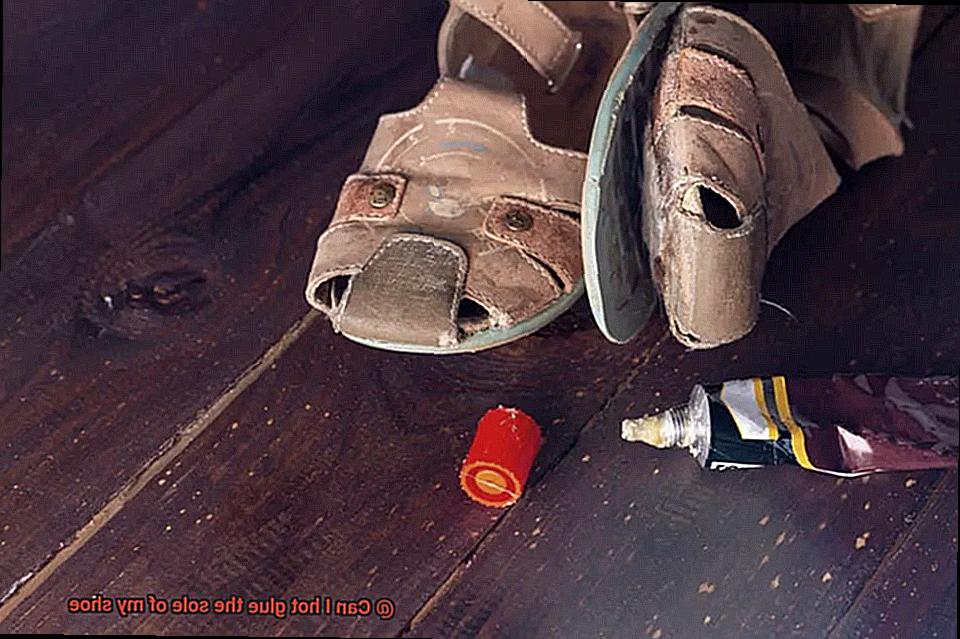
PU Soles: The Pillows of Comfort Enveloping Your Every Step.
In search of heavenly comfort during prolonged periods of standing or vigorous activities? Look no further than the exquisite PU soles. These ethereal cushions possess astonishing shock absorption capabilities, cradling your feet with tender care. Light as a feather, they grant respite to weary soles while defying the onslaught of oil and chemicals, ensuring longevity and enduring bliss.
EVA Soles: A Dance with Feathery Clouds.
Step into a realm where clouds embrace your feet – a dance choreographed by the ethereal EVA soles. With their feathery lightness and unparalleled flexibility, they offer an unrivaled performance on the stage of comfort. Whether sprinting across a track or sauntering through sun-drenched streets, these foam-like soles provide unparalleled cushioning and shock absorption. Let them shield your feet from the heat of summer, for their thermal insulation properties are nothing short of magical.
Factors to Consider When Choosing an Adhesive Product
In our previous section, we explored the delightful variety of sole materials. Now, let’s delve into the intricate details of selecting the ideal adhesive product to mend your beloved shoes. As an expert in this field, I have compiled a comprehensive list of factors that you must consider when choosing an adhesive. So, grab a cup of coffee and join me on this enlightening journey.

Material Compatibility:
Picture attempting to bond a leather sole with an adhesive meant for rubber. Catastrophe awaits. Material compatibility is paramount when selecting an adhesive product. Not all adhesives are created equal, and using the wrong one can lead to weak bonds or even irreversible damage. To ensure a robust bond and preserve your shoe’s integrity, find an adhesive specifically formulated for your sole material.
Bond Strength:
Who wants their repaired shoe sole to detach while striding down the street? Not you. Bond strength is crucial for durability. Seek adhesives that offer a potent and long-lasting bond capable of withstanding the daily stress and strain endured by shoes.
Flexibility:
Shoes are built to move, bend, and twist with our every step. Therefore, it is imperative to choose an adhesive that can withstand these movements without cracking or breaking. Opt for adhesives that provide flexibility, allowing your shoe sole to move naturally without compromising the bond.
Drying Time:
Patience may be a virtue, but sometimes we need our shoes fixed pronto. Consider the drying time of the adhesive before making your selection. Some adhesives dry swiftly, enabling you to wear your cherished shoes in no time. Others may require longer drying periods, which can be inconvenient if you’re in a hurry.
Application Method:
Applying adhesive can be a messy affair if not handled with care. Adhesive products come in various forms, such as liquid glue, glue sticks, or glue guns. Liquid glues offer versatility but demand careful handling to avoid messy application. Glue sticks and glue guns provide more control and are perfect for precise applications. Choose the application method that suits your needs and guarantees precision.
How to Use Adhesive Products for Shoe Repairs
Don’t let them gather dust in the back of your closet just yet. With the right adhesive products and a little know-how, you can restore your footwear to its former glory. In this comprehensive guide, we will walk you through the step-by-step process of using adhesive products for shoe repairs. Get ready to unleash your inner cobbler and give your shoes a new lease on life.
Prepare your shoes for the adhesive magic:
Before diving into the world of adhesives, it’s essential to start with a clean canvas. Take a moment to meticulously clean the surface of your shoes, bidding farewell to dirt, dust, and any remnants of old adhesive. Armed with a brush or cloth, sweep away the debris that stands between your shoes and their revival. For optimal adhesion, consider giving the surface a gentle roughening using sandpaper or a wire brush.
Select the adhesive that suits your shoe’s needs:
Choosing the right adhesive is paramount in ensuring a successful repair. Adhesive products come in various forms, each tailored to specific repair needs and shoe materials. If you’re dealing with a loose sole or need to attach a new one, opt for shoe glue. Its specialized formula bonds leather, rubber, and synthetic materials with ease. For heavy-duty repairs or sole attachments that require extra strength, epoxy adhesive is your go-to option. Keep in mind that while super glue can be used for shoe repairs, its lack of flexibility may not make it ideal for certain materials.
Mindfully follow the manufacturer’s instructions:
Once armed with the perfect adhesive product, it’s time to heed the wisdom of its maker. Carefully read and follow the instructions provided by the manufacturer to ensure optimal results. Remember to apply a thin and even layer of adhesive to both surfaces that require bonding. Allow the adhesive to dry or cure for the recommended amount of time before pressing the surfaces together, creating a bond that can withstand the test of time.
Apply pressure to seal the deal:
To solidify the bond between your shoe’s components, apply some gentle but firm pressure on the repaired area after pressing the surfaces together. You can employ clamps or simply use your nimble fingers to hold them in place for a few minutes. This crucial step ensures that your repair remains intact and resilient, ready to withstand countless steps.
Reinforce when necessary:
For repairs that demand an extra layer of security, consider reinforcing the area with additional measures. If you find yourself dealing with a sizable tear or attaching a new sole, stitches or additional layers of adhesive can be your allies in fortifying the repair. By adding these reinforcements, you create a repair that is as robust as it is aesthetically pleasing.
Professional Assistance for Shoe Repairs
In this post, we’ll delve into the reasons why it’s crucial to seek professional assistance for shoe repairs. From the right tools and expertise to tailored solutions for different shoe types, professional shoe repair shops offer a range of benefits that ensure your shoes receive the care they deserve.
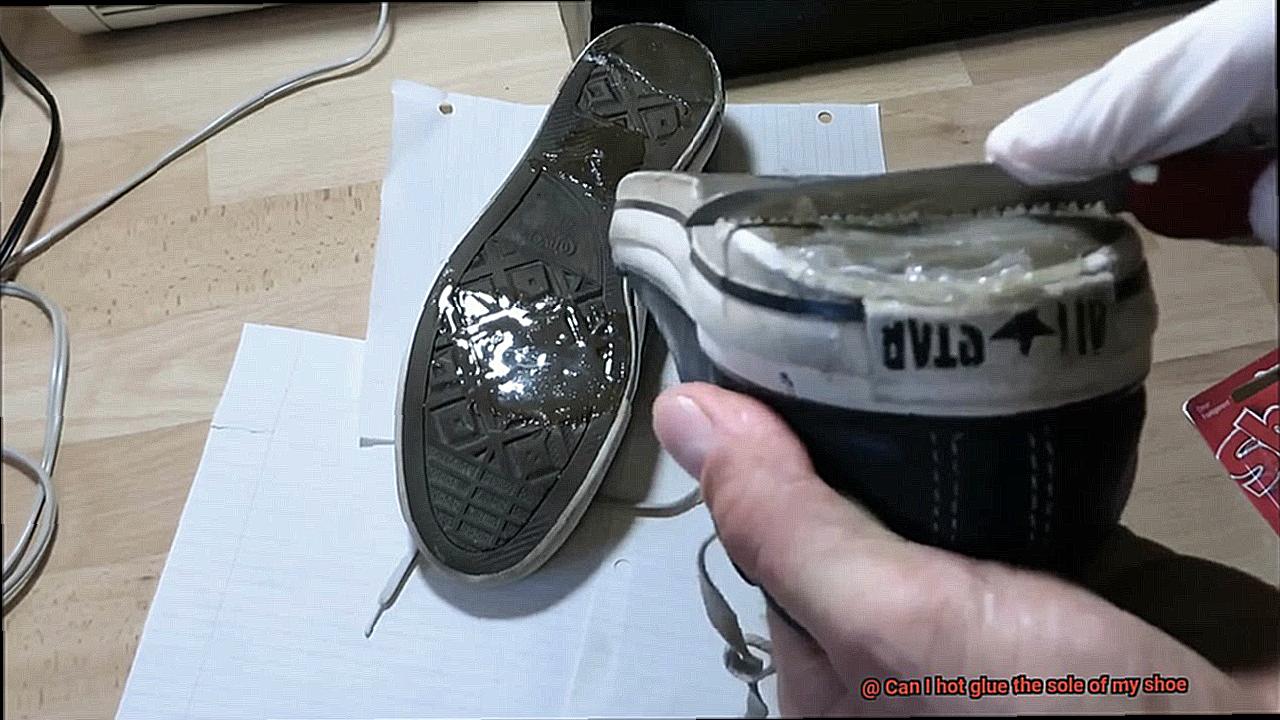
Equipped with Tools and Expertise:
Professional shoe repair shops possess the necessary tools, materials, and expertise to tackle any shoe repair job. Their arsenal includes specialized adhesives designed specifically for shoe repairs, guaranteeing a robust bond between the sole and upper part of the shoe. With their extensive knowledge and experience, these experts can confidently handle even the most intricate repairs.
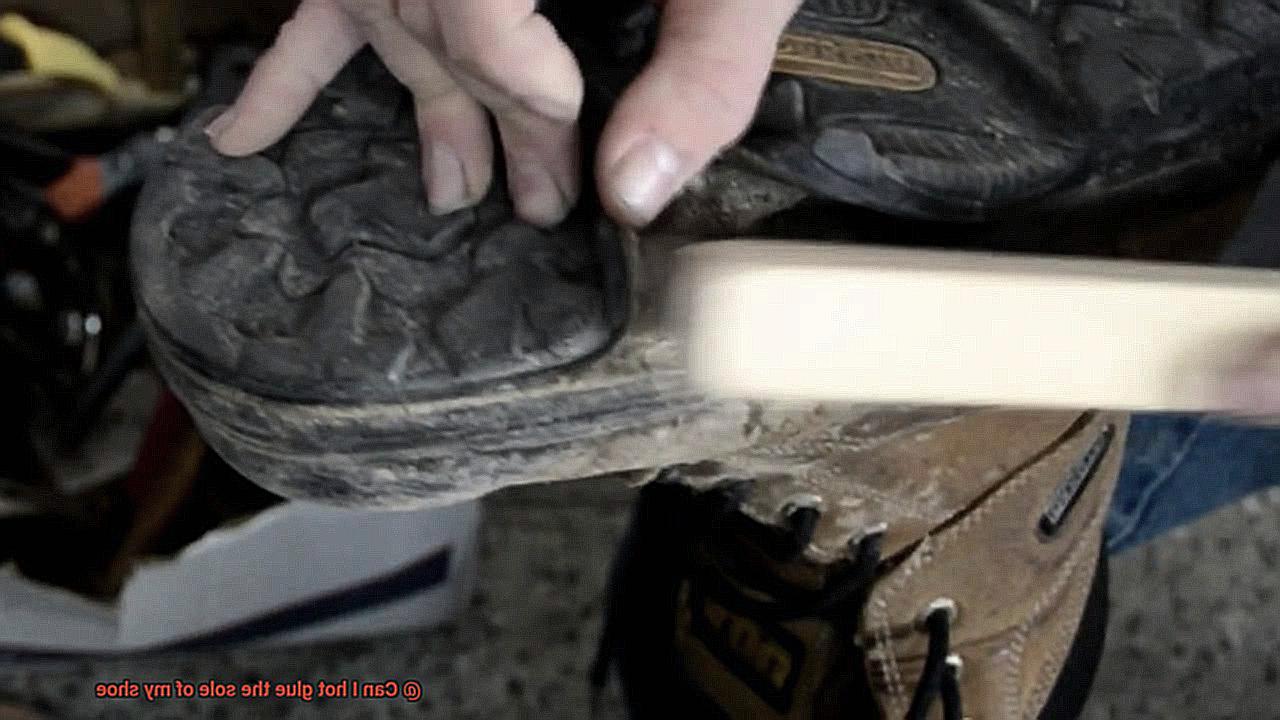
Say No to Hot Glue:
While hot glue may seem like a quick fix, it’s not a suitable long-term solution for shoe repairs. Over time, hot glue can melt or become brittle, leading to the sole coming off once again. Moreover, it lacks the flexibility required to withstand the pressures and movements endured by shoes during regular use. By opting for professional assistance, you can avoid these potential pitfalls and ensure a secure bond that stands the test of time.
Tailored Solutions for Different Shoes:
Every type of shoe has its own unique construction, necessitating tailored repair techniques. Professional shoe repair shops understand this and can provide customized solutions based on your specific footwear needs.
For instance, athletic shoes with cushioned soles require specialized adhesives capable of withstanding the stress and impact associated with sports activities. Seeking professional assistance guarantees that your shoes will receive the appropriate care they require.
Extending Lifespan and Enhancing Comfort:
Professional shoe repair services go beyond simple repairs. These experts assess the extent of damage and recommend solutions that significantly extend the lifespan of your shoes. Whether it’s resoling, reattaching the sole, or replacing worn-out heels, their expertise ensures your shoes are restored to their former glory.
Additionally, professional shoe repair shops can enhance both the comfort and appearance of your shoes, making them feel and look brand new.
r3Stavmm_bM” >
Conclusion
Can you really hot glue the sole of your shoe? The answer is yes. Hot glue can be a quick and easy fix for those pesky sole separations. With just a few simple steps, you can have your shoes back in action in no time.
Firstly, gather all the necessary materials: a hot glue gun, glue sticks, and of course, the shoe in need of repair. Make sure to choose a high-quality hot glue that is suitable for bonding different surfaces.
Next, clean the area where the sole has come loose. Remove any dirt or debris that may hinder proper adhesion. This step ensures that your repair job will be long-lasting and effective.
Now comes the fun part – heating up that trusty hot glue gun. Plug it in and wait for it to reach its optimal temperature. Once it’s ready, carefully apply a thin line of hot glue along the separation on your shoe’s sole.
Take caution not to use too much glue as it may cause discomfort when wearing your shoes. A little goes a long way. Press firmly on both sides of the separated sole to ensure proper bonding. Hold them together until the glue sets.
Allow sufficient time for the glue to dry completely before testing out your newly repaired shoe. This drying period may vary depending on factors such as humidity and temperature. Patience is key here.
It’s important to note that while hot gluing can be an effective temporary fix for minor sole separations, it may not be suitable for more significant damage or heavy-duty use. In such cases, seeking professional assistance or considering alternative solutions might be necessary.
In conclusion, if you find yourself with a loose sole, hot glue can be a handy DIY solution. By following these steps and exercising caution, you can extend the life of your beloved shoes and save some money in the process.

